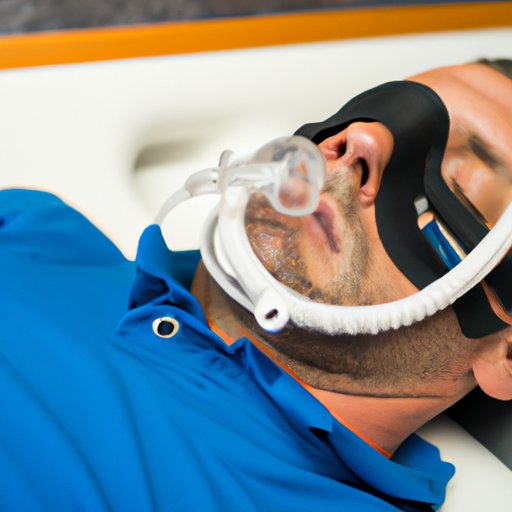Introduction
Continuous positive airway pressure (CPAP) is a type of therapy used to treat sleep apnea, a sleep disorder characterized by pauses in breathing during sleep. CPAP therapy uses a specialized machine to deliver pressurized air into the airway to keep it open, allowing for uninterrupted breathing throughout the night. In this article, we’ll explore the science behind CPAP machines and explain how they work to treat sleep apnea.
Exploring the CPAP Machine: How Does it Work?
A CPAP machine consists of three main components: a motor, a mask, and a tube. The motor draws air from the room and pressurizes it, sending it through the tube to the mask. The mask covers the nose and mouth of the user and delivers the pressurized air directly to the upper respiratory tract, opening the airway and allowing for normal breathing. The amount of pressure delivered is determined by a healthcare provider and can be adjusted depending on the needs of the user.
CPAP machines are designed to provide a steady stream of air throughout the night, allowing users to breathe normally and uninterrupted. This helps to prevent the pauses in breathing associated with sleep apnea, allowing users to get a full night of restful sleep.
Understanding the Basics of a CPAP Machine and Its Uses
CPAP therapy is commonly used to treat sleep apnea, but it may also be used to treat other conditions such as chronic obstructive pulmonary disease (COPD) and central sleep apnea. CPAP therapy has been found to be highly effective in treating these conditions, providing relief from symptoms and improving quality of life.
CPAP machines come in a variety of styles and sizes, with some being more portable than others. Some CPAP machines are designed specifically for travel, while others are meant to be used at home. Regardless of the style or size, all CPAP machines are designed to deliver the same type of pressurized air to the user.
CPAP therapy is generally considered safe and well-tolerated by most users. However, there are some side effects that can occur, including dry mouth, nasal congestion, and headaches. These side effects can usually be managed with the help of a healthcare provider.
The Science Behind CPAP Machines: How Does It Help Combat Sleep Apnea?
CPAP machines work by delivering a steady stream of pressurized air to the upper airway, keeping it open and allowing for normal breathing. This helps to prevent the pauses in breathing associated with sleep apnea. Research has found that CPAP therapy can improve daytime alertness, reduce snoring, and improve overall quality of life.
In addition to reducing the pauses in breathing, CPAP therapy can also help to reduce inflammation in the upper airway, leading to improved lung function. Additionally, CPAP therapy has been found to reduce the risk of other health complications associated with sleep apnea, such as high blood pressure and heart disease.
A study published in the American Journal of Respiratory and Critical Care Medicine found that CPAP therapy was effective in reducing the severity of sleep apnea symptoms, leading to an improvement in overall quality of life. The study concluded that CPAP therapy is “an effective treatment for OSA [obstructive sleep apnea] and should be prescribed for patients with mild to moderate OSA.”
An Overview of CPAP Therapy: How Does It Work?
CPAP therapy is relatively simple to use and can be set up quickly with the help of a healthcare provider. To begin, a healthcare provider will determine the best mask and pressure setting for the user, based on their individual needs. Once the settings have been determined, the user can then attach the mask to their face and turn on the machine.
The CPAP machine will then deliver a steady stream of pressurized air to the user, allowing them to breathe normally throughout the night. The user should monitor the machine regularly to ensure the pressure settings remain optimal. Additionally, the user should take steps to keep the machine clean and free of dust and debris.

A Comprehensive Guide to Understanding How a CPAP Machine Works
In addition to understanding how a CPAP machine works, it’s important to understand how to properly care for and maintain one. Cleaning and maintenance are essential to ensuring a safe and effective CPAP experience. The user should clean the mask, tubing, and humidifier chamber regularly. Additionally, the user should replace any worn or damaged parts as soon as possible.
Troubleshooting is another important part of using a CPAP machine. If the user is experiencing problems with their machine, they should first consult their healthcare provider. Common troubleshooting tips include checking the power supply, adjusting the pressure settings, and ensuring the mask fits properly.
Finally, it’s important to note that CPAP therapy is not the only option for treating sleep apnea. For those who cannot tolerate CPAP therapy, there are alternative treatments available, such as oral appliances and lifestyle modifications. These alternatives may be more suitable for certain individuals.
Conclusion
CPAP machines are a highly effective form of therapy for treating sleep apnea. By delivering a steady stream of pressurized air to the upper airway, CPAP machines help to keep the airway open and allow for normal breathing. Studies have found that CPAP therapy can significantly improve the quality of life for those with sleep apnea. It’s important to understand the basics of CPAP therapy and how to properly care for and maintain a CPAP machine to ensure a safe and effective experience.
(Note: Is this article not meeting your expectations? Do you have knowledge or insights to share? Unlock new opportunities and expand your reach by joining our authors team. Click Registration to join us and share your expertise with our readers.)
